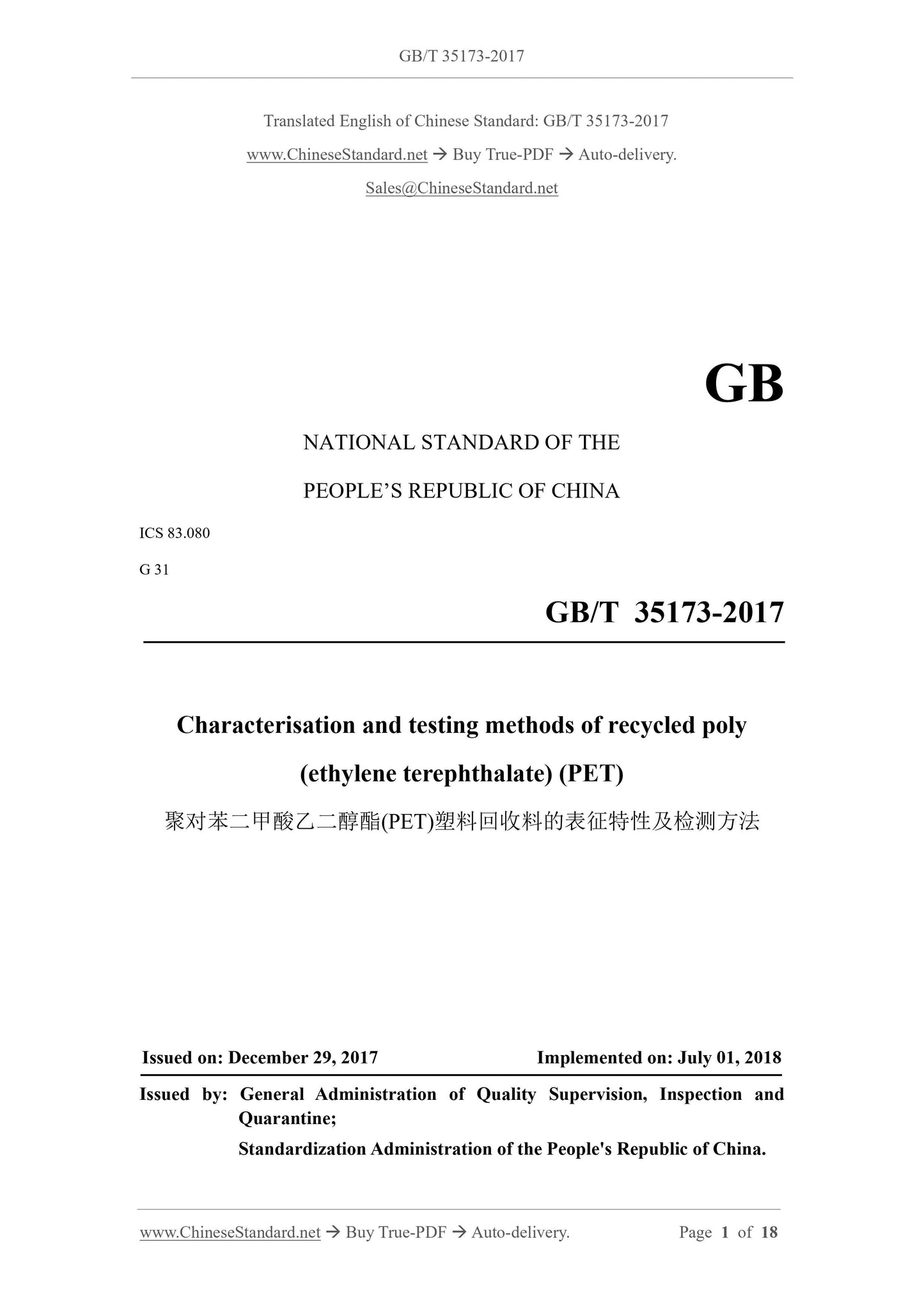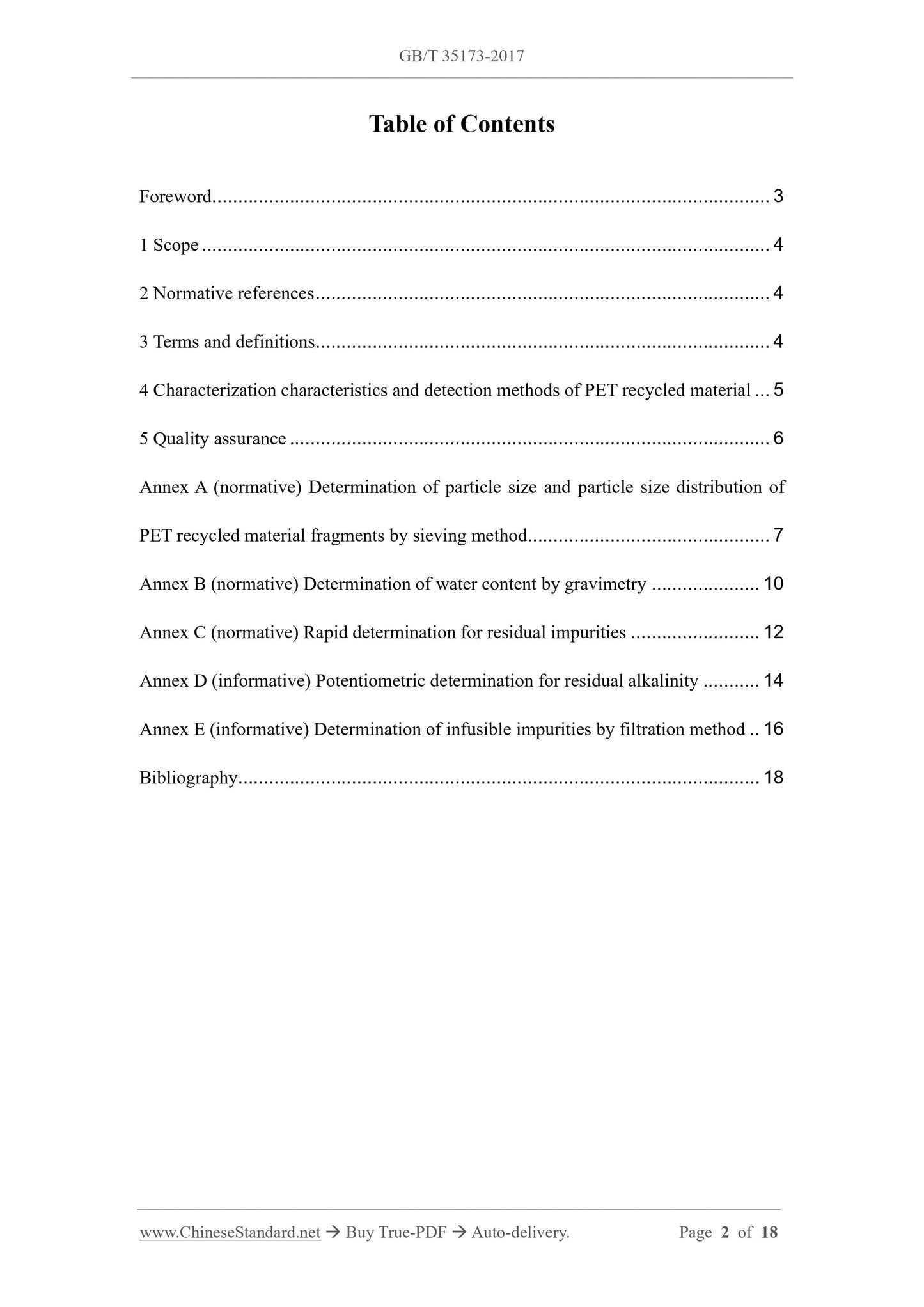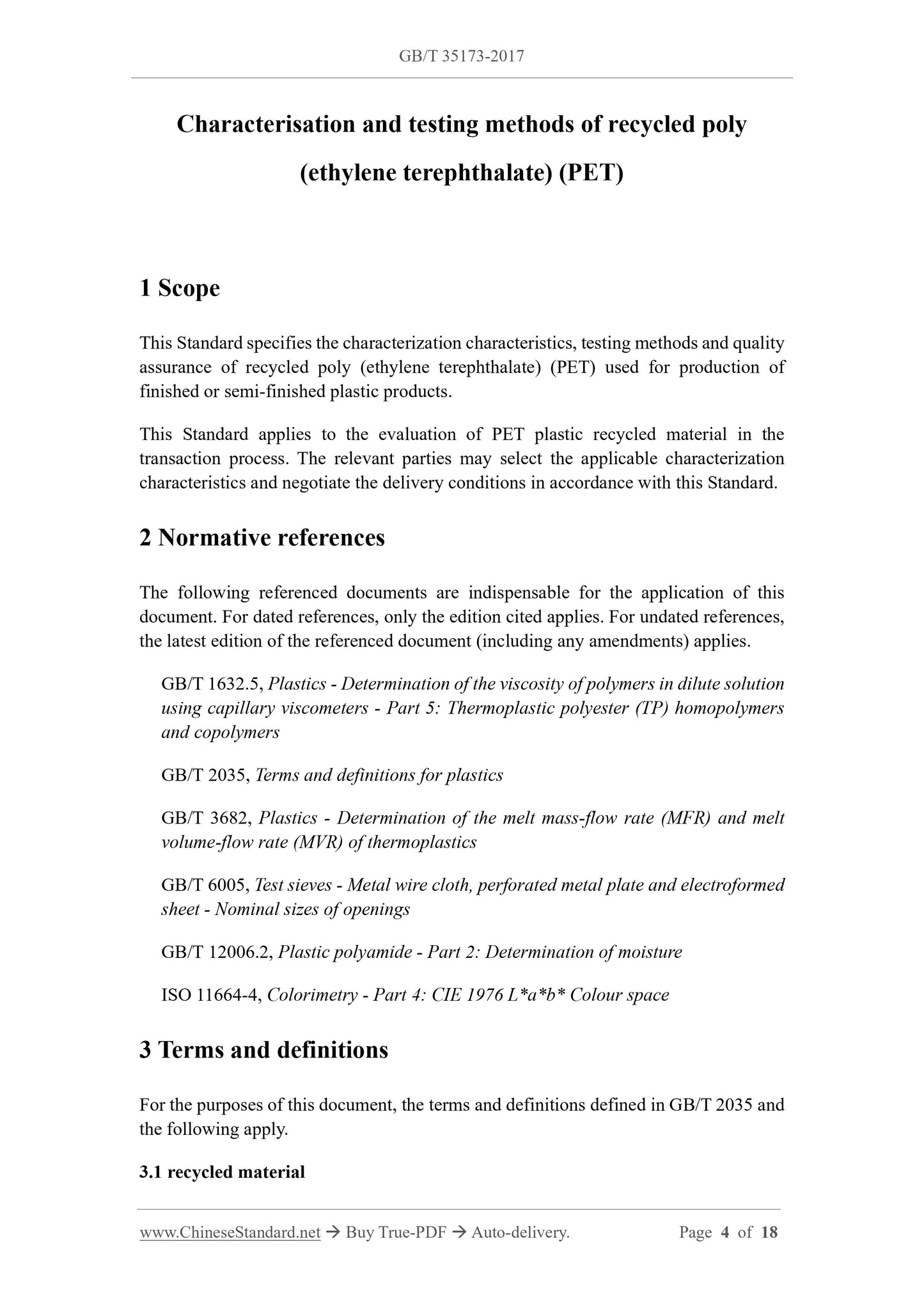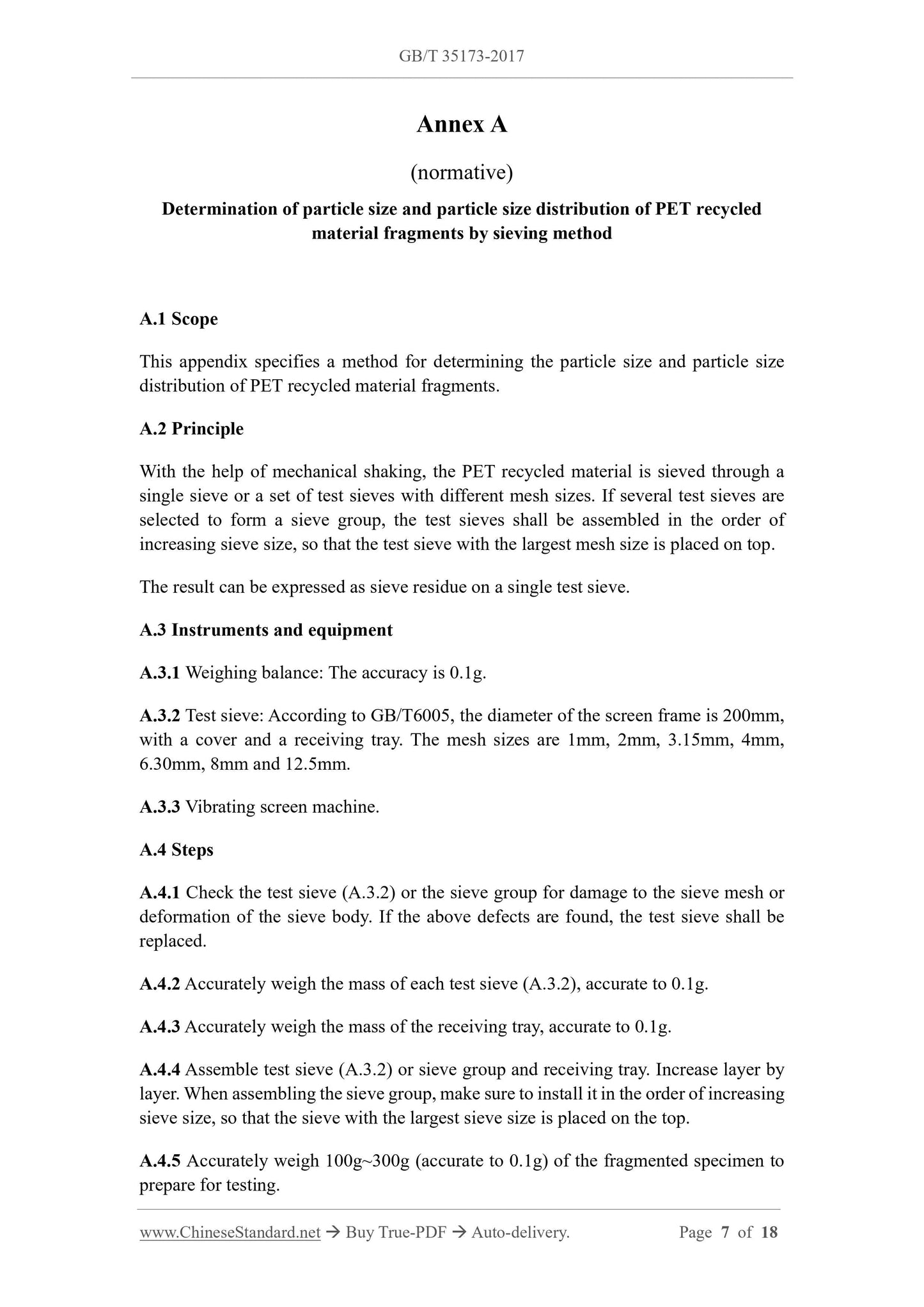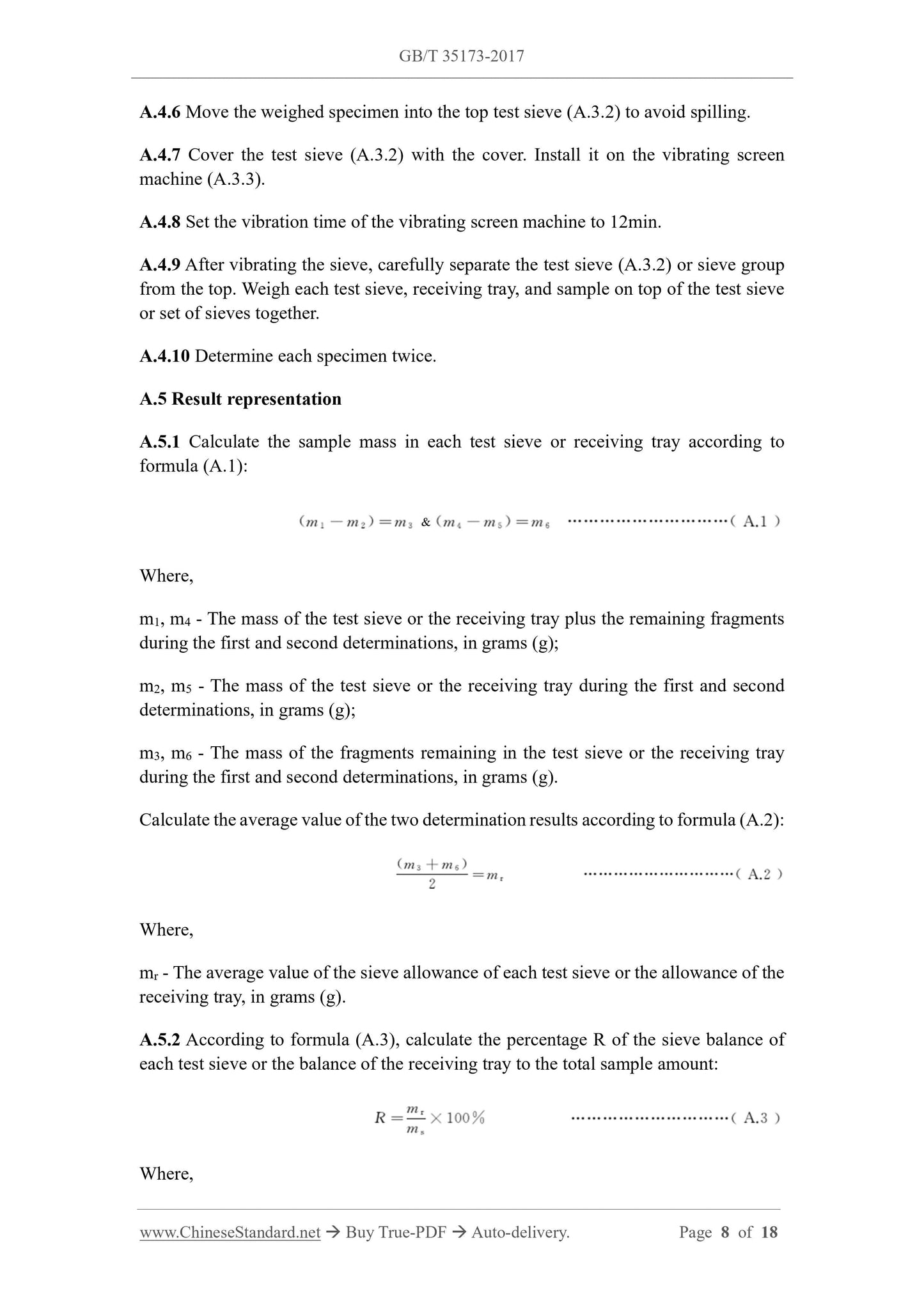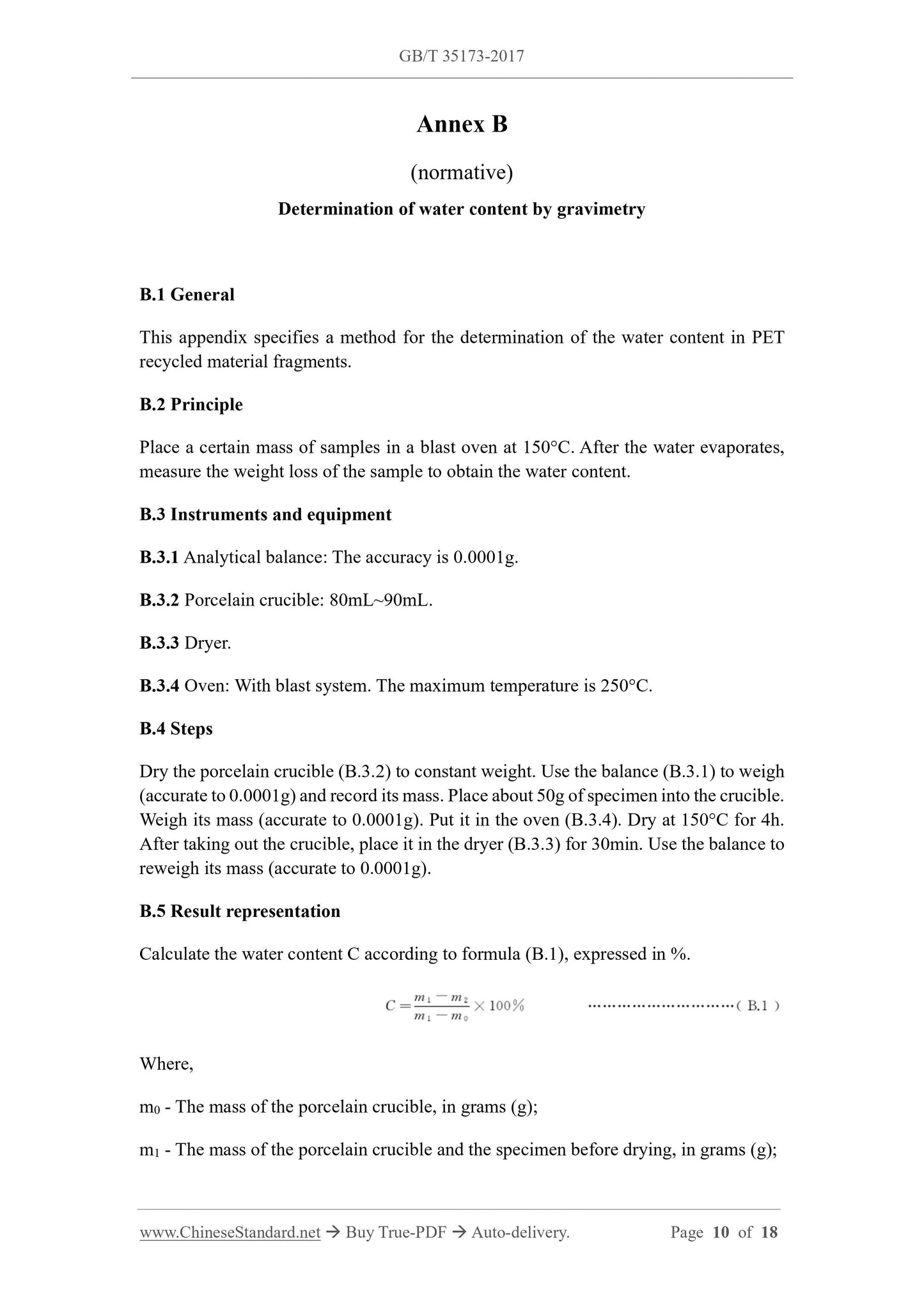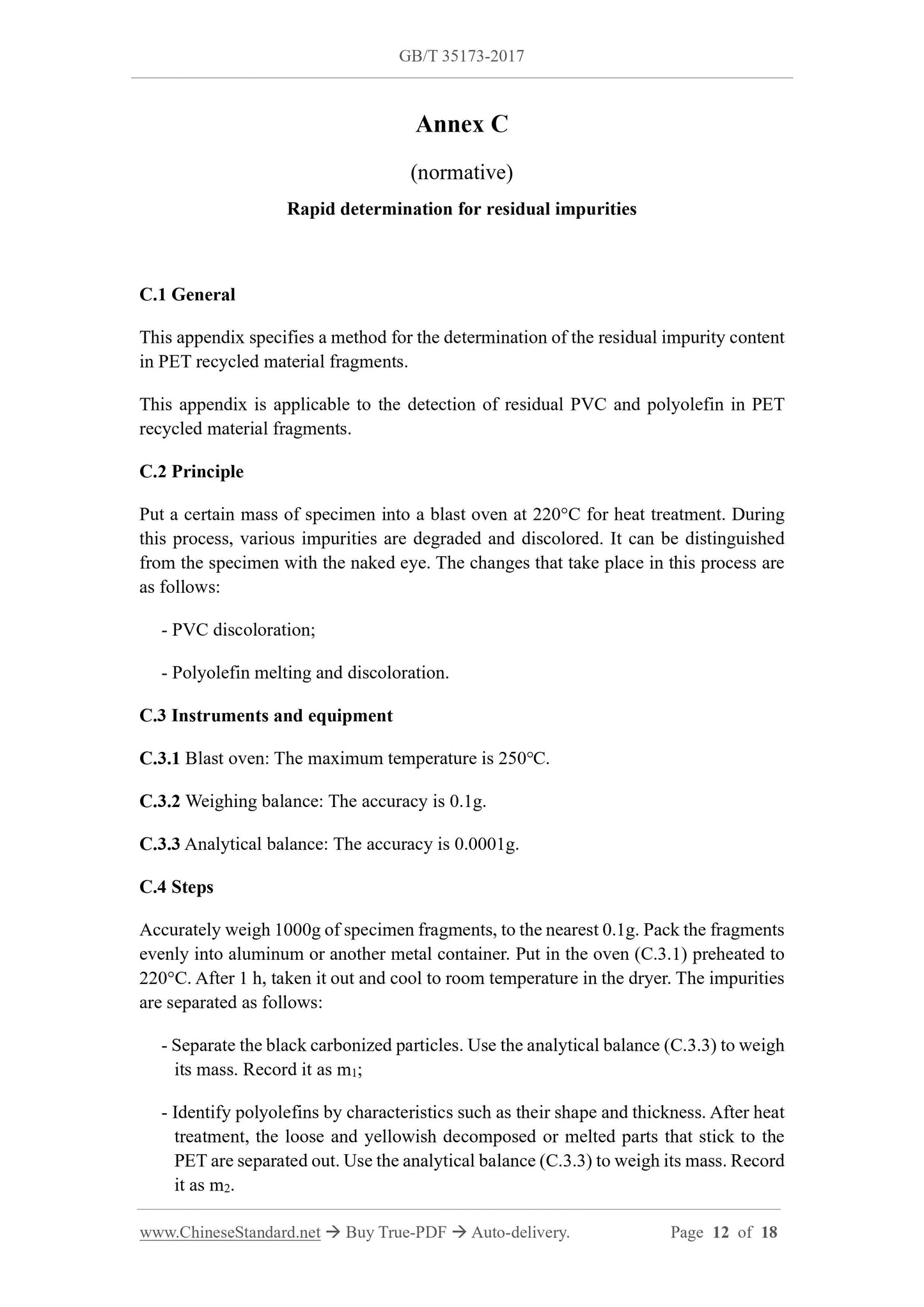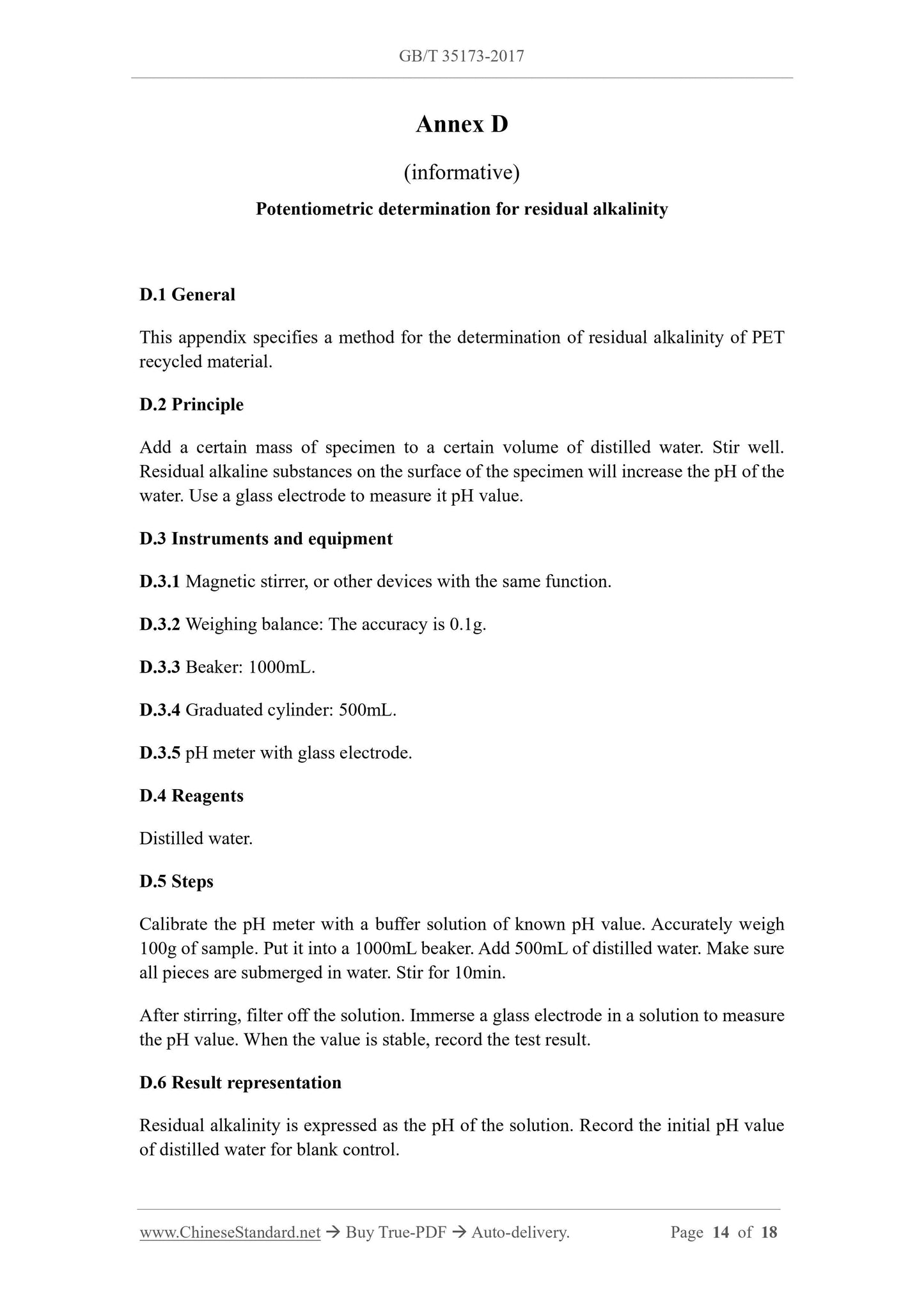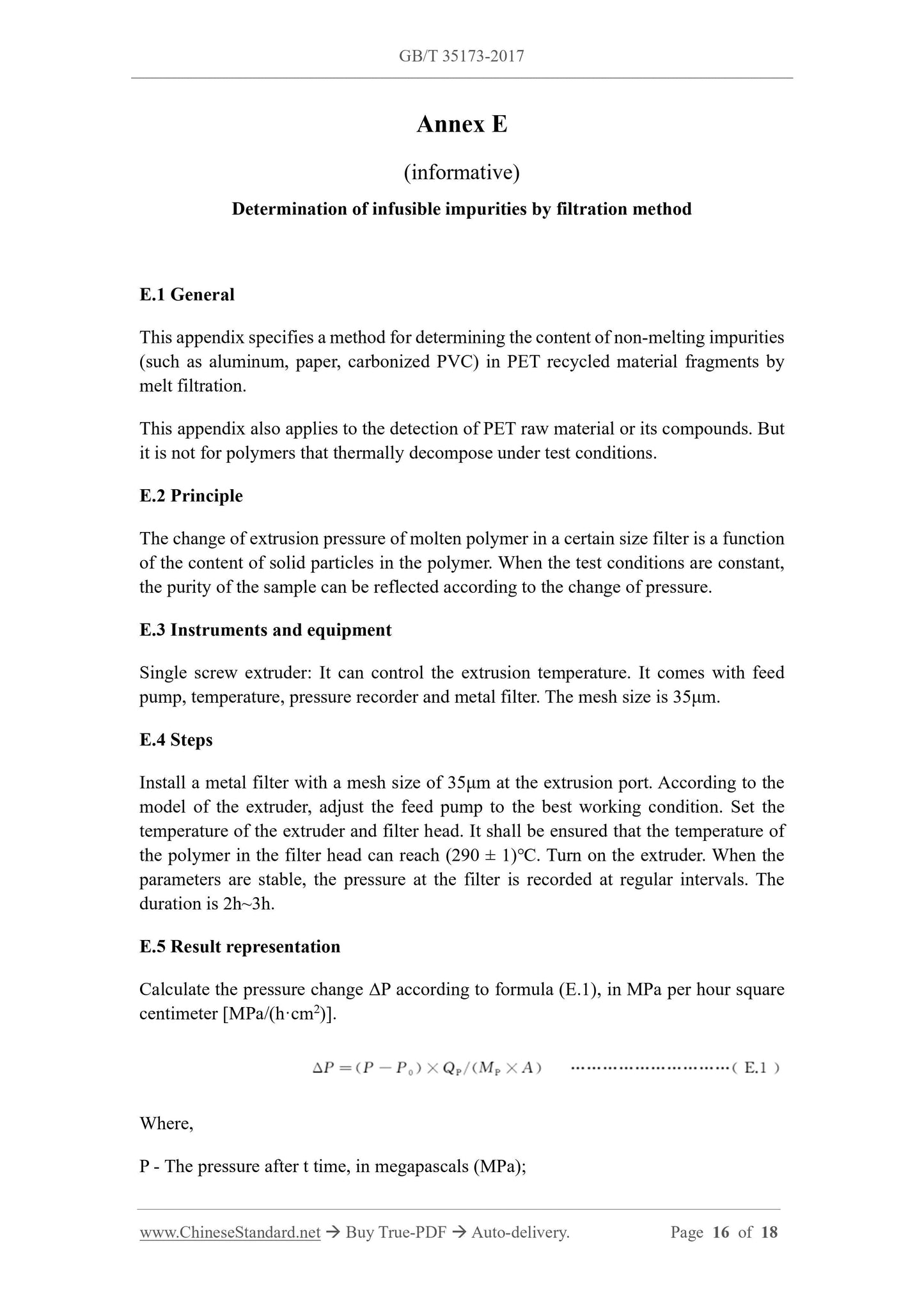1
/
of
9
PayPal, credit cards. Download editable-PDF & invoice In 1 second!
GB/T 35173-2017 English PDF (GBT35173-2017)
GB/T 35173-2017 English PDF (GBT35173-2017)
Regular price
$230.00 USD
Regular price
Sale price
$230.00 USD
Unit price
/
per
Shipping calculated at checkout.
Couldn't load pickup availability
Delivery: 3 seconds. Download true-PDF + Invoice.
Get QUOTATION in 1-minute: Click GB/T 35173-2017
Historical versions: GB/T 35173-2017
Preview True-PDF (Reload/Scroll if blank)
GB/T 35173-2017: Characterisation and testing methods of recycled poly (ethylene terephthalate) (PET)
GB/T 35173-2017
NATIONAL STANDARD OF THE
PEOPLE’S REPUBLIC OF CHINA
ICS 83.080
G 31
Characterisation and testing methods of recycled poly
(ethylene terephthalate) (PET)
ISSUED ON: DECEMBER 29, 2017
IMPLEMENTED ON: JULY 01, 2018
Issued by: General Administration of Quality Supervision, Inspection and
Quarantine;
Standardization Administration of the People's Republic of China.
Table of Contents
Foreword ... 3
1 Scope ... 4
2 Normative references ... 4
3 Terms and definitions... 4
4 Characterization characteristics and detection methods of PET recycled material ... 5
5 Quality assurance ... 6
Annex A (normative) Determination of particle size and particle size distribution of
PET recycled material fragments by sieving method ... 7
Annex B (normative) Determination of water content by gravimetry ... 10
Annex C (normative) Rapid determination for residual impurities ... 12
Annex D (informative) Potentiometric determination for residual alkalinity ... 14
Annex E (informative) Determination of infusible impurities by filtration method .. 16
Bibliography... 18
Characterisation and testing methods of recycled poly
(ethylene terephthalate) (PET)
1 Scope
This Standard specifies the characterization characteristics, testing methods and quality
assurance of recycled poly (ethylene terephthalate) (PET) used for production of
finished or semi-finished plastic products.
This Standard applies to the evaluation of PET plastic recycled material in the
transaction process. The relevant parties may select the applicable characterization
characteristics and negotiate the delivery conditions in accordance with this Standard.
2 Normative references
The following referenced documents are indispensable for the application of this
document. For dated references, only the edition cited applies. For undated references,
the latest edition of the referenced document (including any amendments) applies.
GB/T 1632.5, Plastics - Determination of the viscosity of polymers in dilute solution
using capillary viscometers - Part 5: Thermoplastic polyester (TP) homopolymers
and copolymers
GB/T 2035, Terms and definitions for plastics
GB/T 3682, Plastics - Determination of the melt mass-flow rate (MFR) and melt
volume-flow rate (MVR) of thermoplastics
GB/T 6005, Test sieves - Metal wire cloth, perforated metal plate and electroformed
sheet - Nominal sizes of openings
GB/T 12006.2, Plastic polyamide - Part 2: Determination of moisture
ISO 11664-4, Colorimetry - Part 4: CIE 1976 L*a*b* Colour space
3 Terms and definitions
For the purposes of this document, the terms and definitions defined in GB/T 2035 and
the following apply.
3.1 recycled material
Annex A
(normative)
Determination of particle size and particle size distribution of PET recycled
material fragments by sieving method
A.1 Scope
This appendix specifies a method for determining the particle size and particle size
distribution of PET recycled material fragments.
A.2 Principle
With the help of mechanical shaking, the PET recycled material is sieved through a
single sieve or a set of test sieves with different mesh sizes. If several test sieves are
selected to form a sieve group, the test sieves shall be assembled in the order of
increasing sieve size, so that the test sieve with the largest mesh size is placed on top.
The result can be expressed as sieve residue on a single test sieve.
A.3 Instruments and equipment
A.3.1 Weighing balance: The accuracy is 0.1g.
A.3.2 Test sieve: According to GB/T6005, the diameter of the screen frame is 200mm,
with a cover and a receiving tray. The mesh sizes are 1mm, 2mm, 3.15mm, 4mm,
6.30mm, 8mm and 12.5mm.
A.3.3 Vibrating screen machine.
A.4 Steps
A.4.1 Check the test sieve (A.3.2) or the sieve group for damage to the sieve mesh or
deformation of the sieve body. If the above defects are found, the test sieve shall be
replaced.
A.4.2 Accurately weigh the mass of each test sieve (A.3.2), accurate to 0.1g.
A.4.3 Accurately weigh the mass of the receiving tray, accurate to 0.1g.
A.4.4 Assemble test sieve (A.3.2) or sieve group and receiving tray. Increase layer by
layer. When assembling the sieve group, make sure to install it in the order of increasing
sieve size, so that the sieve with the largest sieve size is placed on the top.
A.4.5 Accurately weigh 100g~300g (accurate to 0.1g) of the fragmented specimen to
prepare for testing.
A.4.6 Move the weighed specimen into the top test sieve (A.3.2) to avoid spilling.
A.4.7 Cover the test sieve (A.3.2) with the cover. Install it on the vibrating screen
machine (A.3.3).
A.4.8 Set the vibration time of the vibrating screen machine to 12min.
A.4.9 After vibrating the sieve, carefully separate the test sieve (A.3.2) or sieve group
from the top. Weigh each test sieve, receiving tray, and sample on top of the test sieve
or set of sieves together.
A.4.10 Determine each specimen twice.
A.5 Result representation
A.5.1 Calculate the sample mass in each test sieve or receiving tray according to
formula (A.1):
Where,
m1, m4 - The mass of the test sieve or the receiving tray plus the remaining fragments
during the first and second determinations, in grams (g);
m2, m5 - The mass of the test sieve or the receiving tray during the first and second
determinations, in grams (g);
m3, m6 - The mass of the fragments remaining in the test sieve or the receiving tray
during the first and second determinations, in grams (g).
Calculate the average value of the two determination results according to formula (A.2):
Where,
mr - The average value of the sieve allowance of each test sieve or the allowance of the
receiving tray, in grams (g).
A.5.2 According to formula (A.3), calculate the percentage R of the sieve balance of
each test sieve or the balance of the receiving tray to the total sample amount:
Where,
Annex B
(normative)
Determination of water content by gravimetry
B.1 General
This appendix specifies a method for the determination of the water content in PET
recycled material fragments.
B.2 Principle
Place a certain mass of samples in a blast oven at 150°C. After the water evaporates,
measure the weight loss of the sample to obtain the water content.
B.3 Instruments and equipment
B.3.1 Analytical balance: The accuracy is 0.0001g.
B.3.2 Porcelain crucible: 80mL~90mL.
B.3.3 Dryer.
B.3.4 Oven: With blast system. The maximum temperature is 250°C.
B.4 Steps
Dry the porcelain crucible (B.3.2) to constant weight. Use the balance (B.3.1) to weigh
(accurate to 0.0001g) and record its mass. Place about 50g of specimen into the crucible.
Weigh its mass (accurate to 0.0001g). Put it in the oven (B.3.4). Dry at 150°C for 4h.
After taking out the crucible, place it in the dryer (B.3.3) for 30min. Use the balance to
reweigh its mass (accurate to 0.0001g).
B.5 Result representation
Calculate the water content C according to formula (B.1), expressed in %.
Where,
m0 - The mass of the porcelain crucible, in grams (g);
m1 - The mass of the porcelain crucible and the specimen before drying, in grams (g);
Annex C
(normative)
Rapid determination for residual impurities
C.1 General
This appendix specifies a method for the determination of the residual impurity content
in PET recycled material fragments.
This appendix is applicable to the detection of residual PVC and polyolefin in PET
recycled mater...
Get QUOTATION in 1-minute: Click GB/T 35173-2017
Historical versions: GB/T 35173-2017
Preview True-PDF (Reload/Scroll if blank)
GB/T 35173-2017: Characterisation and testing methods of recycled poly (ethylene terephthalate) (PET)
GB/T 35173-2017
NATIONAL STANDARD OF THE
PEOPLE’S REPUBLIC OF CHINA
ICS 83.080
G 31
Characterisation and testing methods of recycled poly
(ethylene terephthalate) (PET)
ISSUED ON: DECEMBER 29, 2017
IMPLEMENTED ON: JULY 01, 2018
Issued by: General Administration of Quality Supervision, Inspection and
Quarantine;
Standardization Administration of the People's Republic of China.
Table of Contents
Foreword ... 3
1 Scope ... 4
2 Normative references ... 4
3 Terms and definitions... 4
4 Characterization characteristics and detection methods of PET recycled material ... 5
5 Quality assurance ... 6
Annex A (normative) Determination of particle size and particle size distribution of
PET recycled material fragments by sieving method ... 7
Annex B (normative) Determination of water content by gravimetry ... 10
Annex C (normative) Rapid determination for residual impurities ... 12
Annex D (informative) Potentiometric determination for residual alkalinity ... 14
Annex E (informative) Determination of infusible impurities by filtration method .. 16
Bibliography... 18
Characterisation and testing methods of recycled poly
(ethylene terephthalate) (PET)
1 Scope
This Standard specifies the characterization characteristics, testing methods and quality
assurance of recycled poly (ethylene terephthalate) (PET) used for production of
finished or semi-finished plastic products.
This Standard applies to the evaluation of PET plastic recycled material in the
transaction process. The relevant parties may select the applicable characterization
characteristics and negotiate the delivery conditions in accordance with this Standard.
2 Normative references
The following referenced documents are indispensable for the application of this
document. For dated references, only the edition cited applies. For undated references,
the latest edition of the referenced document (including any amendments) applies.
GB/T 1632.5, Plastics - Determination of the viscosity of polymers in dilute solution
using capillary viscometers - Part 5: Thermoplastic polyester (TP) homopolymers
and copolymers
GB/T 2035, Terms and definitions for plastics
GB/T 3682, Plastics - Determination of the melt mass-flow rate (MFR) and melt
volume-flow rate (MVR) of thermoplastics
GB/T 6005, Test sieves - Metal wire cloth, perforated metal plate and electroformed
sheet - Nominal sizes of openings
GB/T 12006.2, Plastic polyamide - Part 2: Determination of moisture
ISO 11664-4, Colorimetry - Part 4: CIE 1976 L*a*b* Colour space
3 Terms and definitions
For the purposes of this document, the terms and definitions defined in GB/T 2035 and
the following apply.
3.1 recycled material
Annex A
(normative)
Determination of particle size and particle size distribution of PET recycled
material fragments by sieving method
A.1 Scope
This appendix specifies a method for determining the particle size and particle size
distribution of PET recycled material fragments.
A.2 Principle
With the help of mechanical shaking, the PET recycled material is sieved through a
single sieve or a set of test sieves with different mesh sizes. If several test sieves are
selected to form a sieve group, the test sieves shall be assembled in the order of
increasing sieve size, so that the test sieve with the largest mesh size is placed on top.
The result can be expressed as sieve residue on a single test sieve.
A.3 Instruments and equipment
A.3.1 Weighing balance: The accuracy is 0.1g.
A.3.2 Test sieve: According to GB/T6005, the diameter of the screen frame is 200mm,
with a cover and a receiving tray. The mesh sizes are 1mm, 2mm, 3.15mm, 4mm,
6.30mm, 8mm and 12.5mm.
A.3.3 Vibrating screen machine.
A.4 Steps
A.4.1 Check the test sieve (A.3.2) or the sieve group for damage to the sieve mesh or
deformation of the sieve body. If the above defects are found, the test sieve shall be
replaced.
A.4.2 Accurately weigh the mass of each test sieve (A.3.2), accurate to 0.1g.
A.4.3 Accurately weigh the mass of the receiving tray, accurate to 0.1g.
A.4.4 Assemble test sieve (A.3.2) or sieve group and receiving tray. Increase layer by
layer. When assembling the sieve group, make sure to install it in the order of increasing
sieve size, so that the sieve with the largest sieve size is placed on the top.
A.4.5 Accurately weigh 100g~300g (accurate to 0.1g) of the fragmented specimen to
prepare for testing.
A.4.6 Move the weighed specimen into the top test sieve (A.3.2) to avoid spilling.
A.4.7 Cover the test sieve (A.3.2) with the cover. Install it on the vibrating screen
machine (A.3.3).
A.4.8 Set the vibration time of the vibrating screen machine to 12min.
A.4.9 After vibrating the sieve, carefully separate the test sieve (A.3.2) or sieve group
from the top. Weigh each test sieve, receiving tray, and sample on top of the test sieve
or set of sieves together.
A.4.10 Determine each specimen twice.
A.5 Result representation
A.5.1 Calculate the sample mass in each test sieve or receiving tray according to
formula (A.1):
Where,
m1, m4 - The mass of the test sieve or the receiving tray plus the remaining fragments
during the first and second determinations, in grams (g);
m2, m5 - The mass of the test sieve or the receiving tray during the first and second
determinations, in grams (g);
m3, m6 - The mass of the fragments remaining in the test sieve or the receiving tray
during the first and second determinations, in grams (g).
Calculate the average value of the two determination results according to formula (A.2):
Where,
mr - The average value of the sieve allowance of each test sieve or the allowance of the
receiving tray, in grams (g).
A.5.2 According to formula (A.3), calculate the percentage R of the sieve balance of
each test sieve or the balance of the receiving tray to the total sample amount:
Where,
Annex B
(normative)
Determination of water content by gravimetry
B.1 General
This appendix specifies a method for the determination of the water content in PET
recycled material fragments.
B.2 Principle
Place a certain mass of samples in a blast oven at 150°C. After the water evaporates,
measure the weight loss of the sample to obtain the water content.
B.3 Instruments and equipment
B.3.1 Analytical balance: The accuracy is 0.0001g.
B.3.2 Porcelain crucible: 80mL~90mL.
B.3.3 Dryer.
B.3.4 Oven: With blast system. The maximum temperature is 250°C.
B.4 Steps
Dry the porcelain crucible (B.3.2) to constant weight. Use the balance (B.3.1) to weigh
(accurate to 0.0001g) and record its mass. Place about 50g of specimen into the crucible.
Weigh its mass (accurate to 0.0001g). Put it in the oven (B.3.4). Dry at 150°C for 4h.
After taking out the crucible, place it in the dryer (B.3.3) for 30min. Use the balance to
reweigh its mass (accurate to 0.0001g).
B.5 Result representation
Calculate the water content C according to formula (B.1), expressed in %.
Where,
m0 - The mass of the porcelain crucible, in grams (g);
m1 - The mass of the porcelain crucible and the specimen before drying, in grams (g);
Annex C
(normative)
Rapid determination for residual impurities
C.1 General
This appendix specifies a method for the determination of the residual impurity content
in PET recycled material fragments.
This appendix is applicable to the detection of residual PVC and polyolefin in PET
recycled mater...
Share
